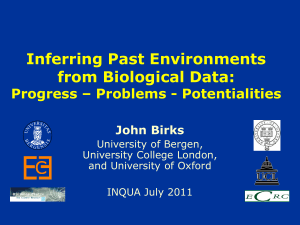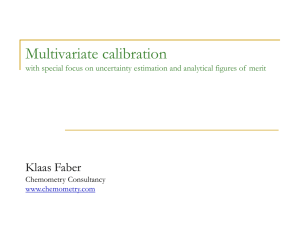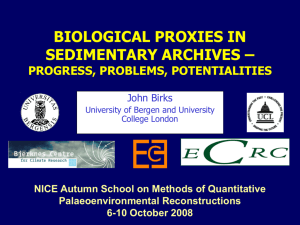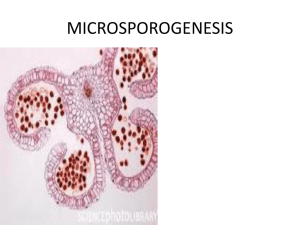Inferring past environments from biological data
advertisement
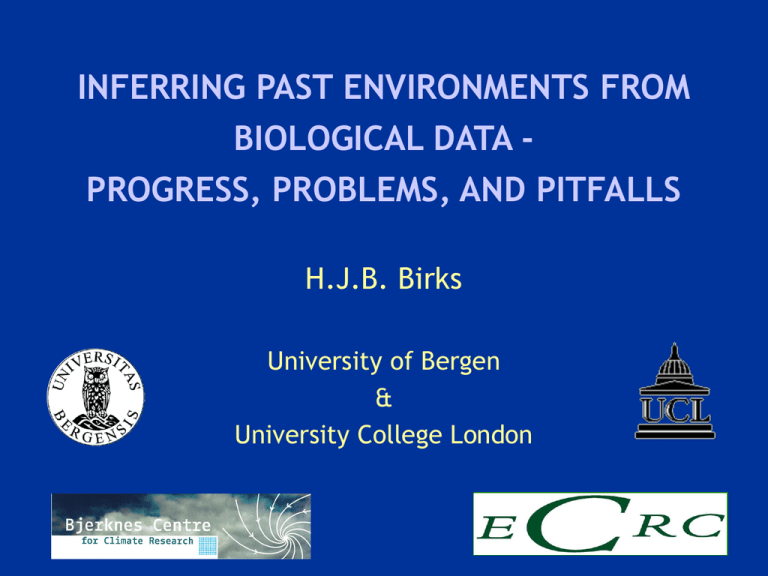
INFERRING PAST ENVIRONMENTS FROM
BIOLOGICAL DATA PROGRESS, PROBLEMS, AND PITFALLS
H.J.B. Birks
University of Bergen
&
University College London
BASIC IDEA OF BIOINDICATION OR
ENVIRONMENTAL RECONSTRUCTION
Fossil biological data
(e.g., pollen, chironomids)
'Proxy data'
Environmental variable
(e.g., temperature)
1, ........... m species
1
YO
t
samples
XO Unknown.
To be estimated
or reconstructed
t
samples
To solve for XO, need modern data or 'training data' or 'calibration set'
1, ........... m species
1
Y
X
n
samples
n
samples
Modern biology
(e.g., pollen, chironomids)
Modern environment
(e.g., temperature)
BASIC BIOLOGICAL ASSUMPTIONS
Marine planktonic foraminifera - Imbrie & Kipp 1971
Foraminifera are a function of sea-surface temperature
Foraminifera can be used to reconstruct past sea-surface temperature
Pollen
Pollen is a function of vegetation
Vegetation is a function of climate
Pollen is an indirect function of climate and can be used to reconstruct
past climate
Chironomids (aquatic non-biting midges)
Chironomids are a function of lake-water temperature
Lake-water temperature is a function of climate
Chironomids are an indirect function of climate and can be used to
reconstruct past climate
Freshwater diatoms (microscopic algae)
Diatoms are a function of lake-water chemistry
Diatoms can be used to reconstruct past lake-water chemistry
Lake-water chemistry may be some weak function of climate
Diatoms may be a weak function of climate
BIOLOGICAL 'PROXY' DATA PROPERTIES
May have 200-300 species, expressed as
proportions or percentages in 200-500 samples
Multicollinearity
Biological data contain many zero values
(absences)
Species invariably show non-linear unimodal
responses to their environment, not simple linear
responses
'PROXIES'
Pollen - good indicators of vegetation and hence indirect indicators of climate.
Betula (birch)
Pinus (pine)
Alnus (alder)
Quercus (oak)
Empetrum nigrum
Agropyron repens
(crowberry)
(Gramineae) (grass)
Modern pollen, identical treatment, all at same magnification, all stained with safranin
Chironomids - good indicators of past lake-water
temperatures and hence past climate
Common late-glacial chironomid taxa. A: Tanytarsina; b: Sergentia; c: Heterotrissocladius; d:
Hydrobaenus/Oliveridia; e: Chironomus; f: Dicrotendipes; g: Microtendipes; h: Polypedilum;
i: Cladopelma. Scale bar represents 50 m.
Freshwater diatoms - excellent indicators of lake-water chemistry
(e.g. pH, total P). Not reliable climate indicators.
BASIC NUMERICAL MODELS
CLASSICAL APPROACH
(1)
Y = f(X) + error
Biology
Environment
(2) Estimate f by some mathematical procedure and 'invert' our estimated (f) to find unknown past environment X0 from fossil data Y0
XO f-1(YO)
INVERSE APPROACH
In practice, for various mathematical reasons, do an inverse regression
or calibration
(3)
X = g(Y) + error
(4)
XO = g(YO)
Obtain 'plug-in' estimate of past environment XO from fossil data YO
f or g are 'transfer functions'
'INVERSE' PROCEDURES
1. Principal components regression. Imbrie & Kipp (1971)
PC1
Y
PC2
X
Multiple linear regression
or polynomial regression of
X on PC1, PC2, PC3, etc.
PC3
PCA components
maximise variance
within Y
Selection of components done visually until very recently. Now crossvalidation is used to select model with fewest components and low
RMSEP and maximum bias.
2.
Two-way weighted averaging. ter Braak & van Dam (1989) and
Birks et al. (1990)
^ by weighted averaging of the
(i) Estimate species optima (u)
environmental variable (x) of the sites. Species abundant at a
site will tend to have their ecological optima close to the
environmental variable at that site. (WA regression).
^ at the sites by weighted
(ii) Estimate the environmental values (x)
^ (WA calibration.)
averaging of the species optima (u).
(iii) Because averages are taken twice, the range of estimated xvalues is shrunken, and a simple 'inverse' or 'classical'
deshrinking is required. Usually regress x on the preliminary
^ and take the fitted values as final estimates of x.
estimates (x)
Can downweight species in step (ii) by their estimated WA
tolerances (niche breadths) so that species with wide
tolerances have less weight than species with narrow
tolerances
3. Weighted averaging partial least squares regression (WA-PLS).
ter Braak & Juggins (1983) and ter Braak et al. (1993)
PLS1
Y
PLS2
PLS3
X
Components selected to
maximise covariance between
species weighted averages and
environmental variable x
Selection of number of PLS components to include based on crossvalidation. Model selected should have fewest components possible
and low RMSEP and maximum bias.
4. Modern analog technique (MAT) = k-nearest neighbours (kNN). Hutson (1980), Prell (1985), ter Braak (1995), et al.
Compare fossil sample t
with modern sample i
Repeat for all
modern samples
Repeat for all
fossil samples
Calculate DC
between t and i
Select k-closest analogues
for fossil sample t
Estimate past environment for
sample t as (weighted) mean of the
environment of the k analogues
Value of k estimated
by visual inspection,
arbitrary rules (e.g.,
10, 20, etc.), or
cross-validation
USE OF METHODS
Marine studies
(foraminifera, diatoms)
-
PCR, some MAT plus variants,
very few WA or WA-PLS uses
Freshwater studies
(diatoms, chironomids)
-
WA or WA-PLS, very few MAT uses
Terrestrial studies
(pollen)
-
MAT plus variants, some WA-PLS
uses
In comparisons using simulated and real data, WA and WA-PLS usually
outperform PCR and MAT but not always.
Classical methods of Gaussian logit or multinomial logit regression and
calibration rarely used (freshwater, terrestrial). Some applications of
artificial neural networks and few studies within a Bayesian
framework.
Bayesian framework may be an important future research direction.
HIDDEN BASIC ASSUMPTIONS
1. Species in training set (Y) are systematically related to the physical
environment (X) in which they live.
2. Environmental variable (XO , e.g. summer temperature) to be
reconstructed is, or is linearly related to, an ecologically important
variable in the system.
3. Species in the training set (Y) are the same as in the fossil data (YO)
and their ecological responses (Gm) have not changed significantly
over the timespan represented by the fossil assemblage.
4. Mathematical methods used in regression and calibration adequately
model the non-linear biological responses (Gm) to the environmental
variable (X).
5. Other environmental variables than, say, summer temperature have
negligible influence, or their joint distribution with summer
temperature in the past is the same as in the modern training set.
MODEL PERFORMANCE AND SELECTION
1. Root mean square error of prediction (RMSEP) as low as
possible.
2. Maximum bias as low as possible.
3. Smallest number of components to avoid 'overfitting'.
Based on leave-one-out cross-validation, n-fold crossvalidation, or boot-strapping. Very rare to have an independent
test set.
MODEL VALIDATION
Compare reconstructed values with historical data. Rarely possible as
few historical data exist.
Renberg & Hultberg (1992)
But when done,
sometimes the
model that gives
the closest correspondence is
not the model
with lowest
RMSEP or maximum bias!
Conflict between model performance and selection based on crossvalidation and validation results using independent historical test-sets.
AN EXAMPLE OF RECONSTRUCTING
PAST CLIMATE FROM POLLEN DATA
304 modern pollen
samples Norway,
northern Sweden,
Finland (Sylvia Peglar,
Heikki Seppä, John
Birks, Arvid Odland)
Seppä & Birks (2001)
Performance statistics - WA-PLS - leave-one-out cross-validation
RMSEP
R2
Max. bias
July temperature (7.7 - 17.1ºC)
1.0ºC
0.73
3.64ºC
Annual precipitation (300 - 3234 mm)
341 mm
0.71
960 mm
Seppä & Birks (2001)
Seppä & Birks (2001)
Summary pollen diagram from Tsuolbmajavri, northern Finland. The age scale in
modelled calibrated years BP is shown along with four phases. The total pollen- and
spore-accumulation rate (grains cm-2 yr-1) is also shown. The hollow silhouette curves
denote the 10 x exaggeration of the percentages.
RECONSTRUCTIONS
Seppä & Birks (2001)
RECONSTRUCTION VALIDATION
Tibetanus, Abisko Valley, Sweden
Isotopes
Inferred from
pollen
Inferred from
Theory
pollen
Hammarlund et al. (2002)
BROAD-SCALE PATTERNS
Changes in July summer temperature relative to present-day
reconstructed temperature on a south-north transect west of the
Scandes mountains. 16 sites covering all or much of the Holocene.
South
North
Anne Bjune et al.
FINE-RESOLUTION CHANGES
Inferred mean
July air
temperature
Oxygen isotope
ratios in
Greenland icecore
Brooks & Birks,
(2000)
STATISTICAL AND BIOLOGICAL
PROBLEMS AND PITFALLS
1.
Sample specific errors of reconstruction for fossil samples.
Estimate by boot-strapping.
Mean square error of prediction (MSEP) =
Error due to variability in
estimates of species parameters in the training set
(s.e. of boot-strap estimates)
s1
2
ˆ
( xi ,boot xi ,boot )
boot
n
Error due to variation in species
abundances at a given environmental value (actual prediction
error between observed and
mean boot-strap estimate)
+
boot
( xi ,boot xi ,boot )
n
2
s2
where xi,boot is the mean of xi,boot for all cycles when i is in the test set.
RMSEP = (s1 + s2)½
(s1 usually ca. 25% of RMSEP, s2 ca. 75%)
For temperature
RMSEP usually 1-1.5ºC (about 10% of the
modern range sampled)
pH
RMSEP usually 0.3-0.5 pH units (about 10%)
Components of RMSEP
(i)
Within-lake variability - Heiri et al. (2002) Maximum of 15% of
total RMSEP.
(ii) Variability in modern environmental data - Nilsson et al. (1996).
Can be 30-40% (even 70%) of total RMSEP. Major problem. Cannot
take account of natural variability of environmental data.
(iii) Variance in the model (model error or lack of fit).
What to do with sample specific errors?
There is a consistent temporal trend but also continuous overlap in RMSEP!
2. How do we identify signal from noise in reconstructions?
LOESS smoothers are a help.
Seppä & Birks
(2002)
Trends or RMSEP?
Brooks & Birks (2001)
3. Different methods, although they have similar modern model
performances, can give very different reconstruction results.
Birks (2003)
4. Some indication of consistent model bias when applied to fossil
data.
MAT -
low variability, insensitive
WA -
some variability, overestimates at low values
WA-PLS -
more variability
PCR -
considerable variability
but in terms of modern model performance, all seem good in
terms of RMSEP and maximum bias.
Extensive experiments using simulated independent test data-sets
currently underway by Richard Telford are showing important
model differences and biases.
5. Biological data, when sampled over natural environmental
gradients, show a mixture of symmetric unimodal (40%) and
monotonic responses (40%) and some skewed unimodal responses
(5%) and no statistically significant responses (ca. 15%), great
variation in species tolerances or niche breadths, and a
compositional turnover gradient of 3-4 standard deviations.
Perhaps too many monotonic responses to feel comfortable with a
unimodal-based model like WA or WA-PLS but too many unimodal
responses for linear-based models, like PLS or PCR.
Classical approach based on Gaussian or multinomial logit
regression and calibration (tried but dropped because of computational limitations in the 1990s) should be re-investigated, possibly
within a Bayesian framework (e.g. Toivenen et al. (2001); Korhola
et al. (2002)) but incorporating a priori ecological information
about the species concerned (depth preferences, lake-chemical
preferences, sediment preferences) as priors or conditionals.
6. Incorporation of species tolerances (niche widths) into WA-PLS
is needed so that species with narrow tolerances ('good'
indicators) have greater weight in the model.
7. Use non-linear deshrinking equations (e.g. smoothing spline)
in WA or WA-PLS because the pattern of initially estimated x
in relation to observed x is often non-linear, especially at the
gradient ends ('edge effects').
8. Some species may show great dominance and abundance in
some ecological settings ('weeds') but then occur with lower
abundance in other settings. Great dominance can bias
estimates of species parameters, not only of the few
dominants, but also of the other species because of the
percentage compositional constraint.
9. Do we really need all 200-300 species in a calibration set?
Would a model based on only those species that are
necessary for the model to perform well be more robust as it
is not so 'overfitted' as a model based on 200-300 species?
ANN with a backward-elimination pruning algorithm, Racca et
al. (2003)
SWAP diatom-pH data-set
167 samples
267 species
18.5% +ve data entries
pH 4.3-7.3
Species N2 1-120.9
Sample N2 5.1-57.2
Could eliminate 85% of species with little change in model
performance
RMSEP
maximum bias
All 267 species
0.32
-0.44
37 species remaining
0.33
-0.46
Use difference between RMSE(apparent) and RMSEP(jack-knife) as a guide to
possible model 'overfitting'.
Racca et al. (2003)
In general we have many species and few lakes in our modern
calibration sets. 'Curse of dimensionality' and hence model overfitting.
Ideally ratio of species number to lake number should be as close to 1
as possible to minimise 'curse of dimensionality'.
Racca et al. (2003)
How to find minimal set of 'driving' species in WA or WA-PLS?
10. Covarying environmental variables e.g. temperature and lake
trophic status (e.g. total N or P) or temperature and lake
depth
Brodersen &
Anderson (2002)
pH and
climate
Anderson
(2000)
11. Use of different proxies - different proxies may give different
reconstruction, e.g. mean July temperature at Bjørnfjell,
northern Norway.
Validate using another proxy - macrofossils of tree birch
Importance of independent validation
12. One large modern calibration data-set or several regional datasets?
Merging data-sets increases the floristic diversity and
environmental range of the resulting transfer function but can
introduce further noise due to secondary environmental
gradients.
Dynamic or local calibration data-set. Use MAT to find 10-20
closest modern analogues for each fossil sample in a core, and
use these selected samples as a local calibration data-set for that
site.
Current evidence suggests a modest improvement only in RMSEP
and maximum bias of about 2-5%.
13. Hidden assumption number 5. 'Other environmental variables
than, say, summer temperature have neglible influence or
their joint distribution with summer temperature in the past is
the same as the training set.'
Climate model and glaciological results suggest that the joint
distribution between summer temperature and winter
accumulation has not been the same in the past 11,000 years.
Good evidence to suggest that lake-water pH has decreased
naturally (soil deterioration) whilst summer temperature rose
and then fell in the last 11,000 years.
In Norway today, lake-water pH is negatively correlated with
summer temperature because lakes of pH 6-7.5 are on basic rock
and this happens in Norway to occur mainly at high altitudes and
hence at low temperatures. In the past after deglaciation,
almost all lakes had a higher pH than today, so the pHtemperature relationship in the past was different than today.
PROJECTS THAT HAVE STIMULATED OUR
TRANSFER FUNCTION WORK
SWAP
NORPAST
Surface
Water
Acidification
Project
1998-2002
1987-1990
NORPAST-2
1995-2000
NFR
KILO
1993-1996
2000-2004
NFR
SETESDAL
1996-1999
2003EU
CHILL
1998-2001
PERSON WHO HAS STIMULATED OUR TRANSFER FUNCTION WORK
Major attributes of Cajo:
1. Wonderful person and loyal
friend
2. Exceptional scientist with over
7400 citations
3. Revolutionised numerical ecology
and quantitative palaeoecology
with his creative ideas,
remarkable powers of synthesis,
and genius at working at the
interface between practical
ecology and statistical theory.
Cajo ter Braak, April 1992
Thank you Cajo, for all your
contributions in the last 20 years.
